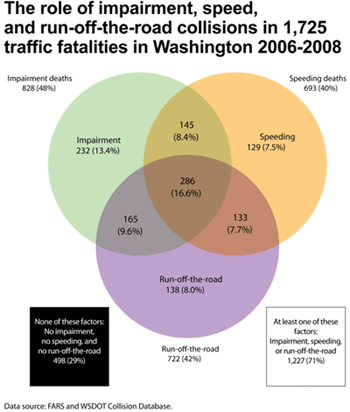|
Search the Noteworthy Practices database Tiered Emphasis Areas for Statewide and County Safety Planning – WashingtonOriginal publication: HSIP Noteworthy Practice Series, Revisiting SHSP Emphasis Areas; FHWA-SA-11-02; 2011 (PDF, 1.9MB)Publication Year: 2011In 2000, prior to SAFETEA-LU, Washington State wrote Target Zero: A Strategic Plan for Highway Safety. The Target Zero Steering Committee, in cooperation with state, local, and private agencies, designed a plan to support a 30-year vision to achieve zero traffic deaths and disabling injuries. When SAFETEA-LU mandated states develop Strategic Highway Safety Plans (SHSP) in 2005, Washington State was well prepared to meet the challenge. Previously, the Washington Traffic Safety Commission (WTSC), Washington State Department of Transportation (WSDOT), and other partners focused on trying to meet all traffic safety needs by spreading resources over a multitude of emphasis areas and projects. The analytic nature of the SHSP made it clear that a change in tactics and strategic planning was required to more effectively prioritize the traffic safety emphasis areas and apply the resources needed to address the Target Zero vision. The Target Zero workgroup conducted an exhaustive analysis of 11 years of crash and trend data to determine which emphasis areas had the greatest potential to reduce deaths and disabling injuries. Recognizing traffic collisions are often attributable to multiple factors, data analysis revealed impairment and speed were highly associated with every other category of crashes (e.g., impairment and/or speed accounted for over one-half of all run-off-the-road collisions) The Target Zero Committee concluded if Washington State can meaningfully reduce impaired driving and speeding, death rates will be cut across the board, therefore, they identified impaired driving and speed as the top priority areas. In setting priorities for the remaining traffic safety issue areas, the committee looked at the number of over-all traffic crashes, disabling injuries, and deaths; the ability of strategies to reduce disabling injuries and deaths; and the importance of the issue in promoting overall traffic safety (such as improving traffic data and EMS services). The resulting Target Zero update (published in February 2007) established four priority levels covering 22 emphasis areas to serve as a guide for related safety programs and for allocating limited safety resources. It also established a schedule of annual evaluation and revision every few years. Data analysis measuring progress and strategy effectiveness are the basis for revisiting emphasis areas and strategies.
Following that model, the process for updating Target Zero began again with intensive data analysis and review of traffic safety planning documents between June and November 2009. The 2010 Target Zero update maintains the four-tier priority structure for guiding resource allocation and implementation efforts, with changes made to address new trends in fatal and serious injury crashes:
In addition to revising statewide emphasis areas, updating Target Zero included efforts to improve county level safety planning through use of a consistent framework. A review of data found prioritization of statewide emphasis areas was heavily influenced by the most populous counties and cities, which did not necessarily reflect the same priorities for all areas. To address these discrepancies, data analysis was conducted for each individual county and presented in the same four-tier priority level framework. Key Accomplishments
ResultsWashington’s SHSP defines the emphasis areas and the priorities the State has determined have the greatest potential to continue reductions toward the goal of zero fatalities and serious injuries by 2030. Fatalities in the State have steadily dropped since 2005, down 8.6 percent from 2007 to 2008, with preliminary figures for 2009 showing a 6.1 percent decline in fatalities. The traffic fatality rate is also trending downwards dropping to 0.94 deaths per 100 million vehicle miles traveled (VMT) in 2008, the State’s lowest rate on record. ContactLowell Porter Publication Year: 2011 |
